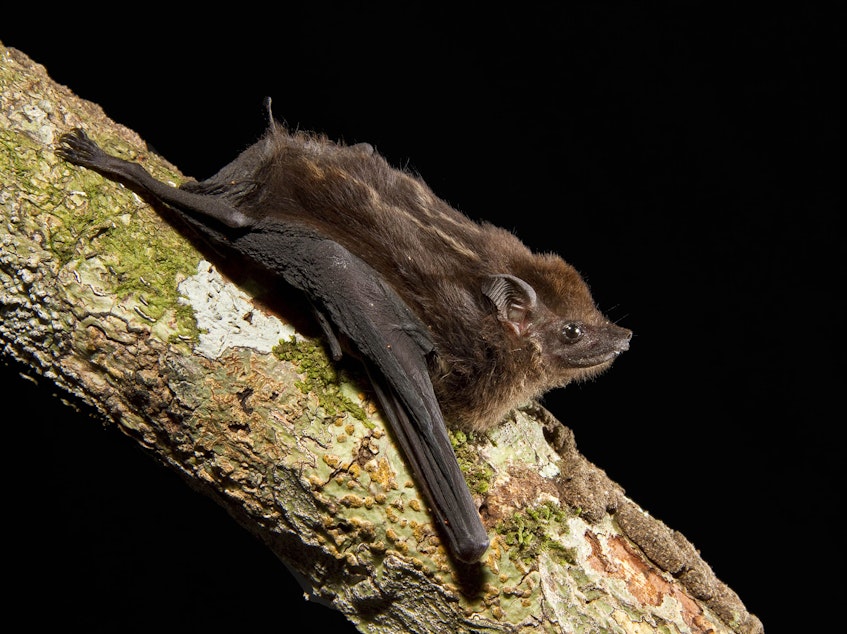Bats Love To Babble — Just Like Humans

Spend any time around a baby and you're likely to hear some babbling. Now, new research shows baby bats can do it too.
A paper published on Thursday in the latest issue of the journal Science finds similarities between the babbling of human infants and the babbling of the greater sac-winged bat (Saccopteryx bilineata) — a small species of bat that lives in Central and South America.
The researchers believe that bats and humans both evolved babbling as a precursor to more complex vocal behavior such as singing, or, in the case of people, talking.
"It's crazy," that two species which are so distantly related both babble, says Ahana Fernandez, an animal behavioral ecologist at the Museum of Natural History in Berlin, Germany.
Fernandez, a co-author on the new paper, hopes that the similarities in infant sounds might eventually reveal common genes used in the process of vocal learning.
Sponsored
Different species, similar babbling
The greater sac-winged bat is a relatively unassuming little creature. "They're really cute," says Fernandez. "They have friendly faces."
Fernandez has spent countless hours watching the bats and recording their sounds. To the human ear, their babbling can sound like a series of repetitive, high-pitched chirps.
"Usually we have a colony where we have several bat pups and then one of the pups starts to babble," she says. "They babble for sometimes 40 minutes."
Their babbling is unique. Although songbirds and humans babble, researchers have not found any other bat species that babbles.
Sponsored
Years ago, it was Mirjam Knörnschild, the head of the museum's behavioral ecology and bioacoustics laboratory (and Fernandez's boss), who first noticed the bat pups doing something that sounded like babbling. She thought it sounded like human babies, and when Fernandez started working with the bats, she heard it too: "It's so conspicuous, it's so loud," she says. "And yes, I was also thinking about human infants that babble."
Fernandez and the research team set out to systematically study the babbling. They identified a set of eight different characteristics that are found in human baby babble. For example, human babies babble in a way that is non-random: "They produce a syllable type in a rhythmic way... 'ba ba ba' and then switch to the next one 'da da da,'" she says.
When the researchers listened to the bats, they found that their babbling was similar. Like babies, the bat pups repeated precursor "syllables" that eventually show up in their songs when they are fully grown. The babbling was also rhythmic and universal among all the bat pups, even though only the males "sing" later in their lives.
Is babbling a better way to cry?
The work of Fernandez and her colleagues does seem to rigorously show that this bat species babbles, says Erich Jarvis, a researcher at the Rockefeller University in New York who studies vocal learning in songbirds.
Sponsored
"Their findings are consistent with the hypothesis that babbling and vocal learning abilities go hand in hand," he said in an e-mail.
But that still leaves the question of how babbling evolved in the first place, says D. Kimbrough Oller, a professor in the School of Communication Sciences and Disorders at the University of Memphis, who was not directly involved with the study.
One hypothesis is that babbling began as a way to get the attention of parents, without the annoyance of constant crying, he says. By babbling, babies could be signaling their fitness, and that they are worth attending to.
"Once babbling is off the ground, it can supply a foundation for the adult of vocal capabilities that can be used for something else," Oller says.
In other words, babbling may have begun as a simple alternative to crying, but it quickly found an evolutionary use in vocal learning species, allowing infants to develop the skills needed later in life.
Sponsored
Jarvis thinks babbling may exist on more of a continuum, with some species that don't learn songs and language doing it, too. He says this latest study of babbling in bats should provide the foundation for future research into babbling and vocal learning in other animals.
As for the bats, Fernandez says for now the greater sac-winged bat is the only species known to babble, but she believes there are other species out there: "We have more than 1,400 bat species worldwide," she says. "I am absolutely sure we're going to find another one." [Copyright 2021 NPR]



